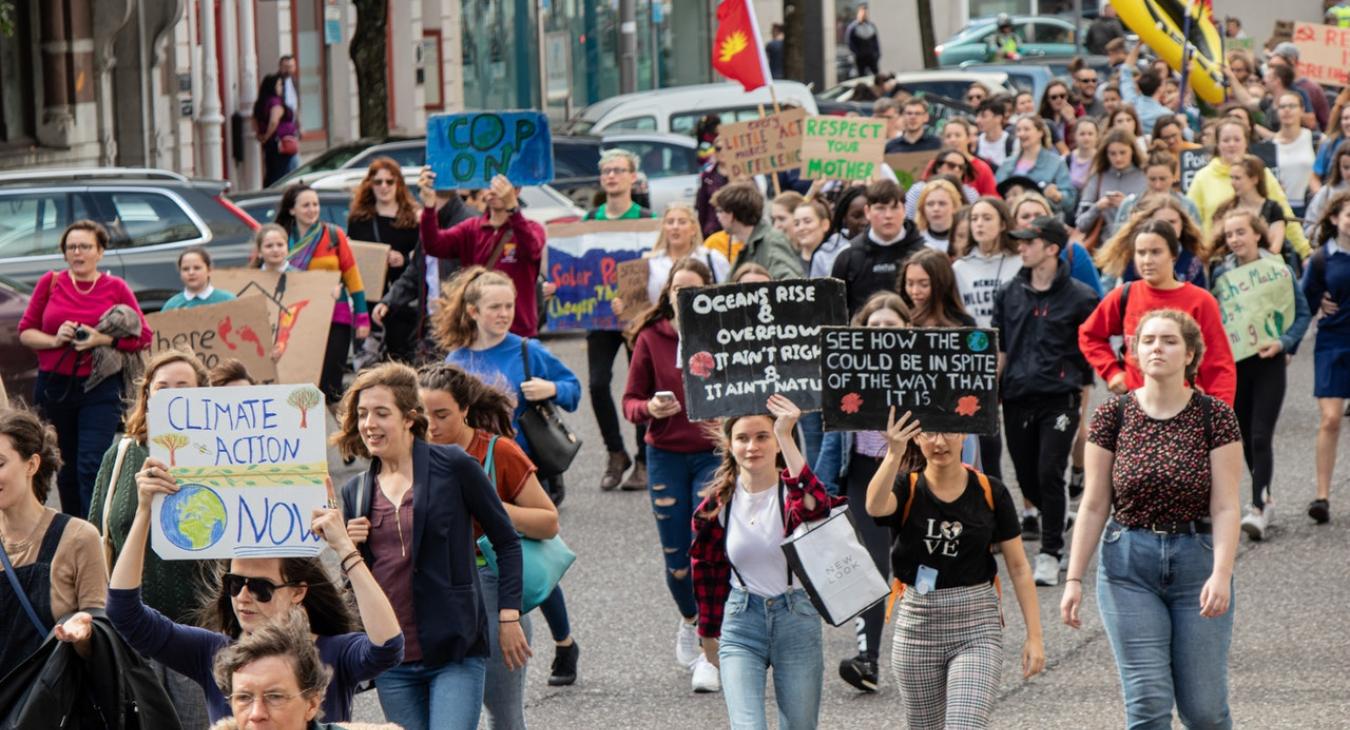
Assessing the likely economic impact of 12 weeks of coronavirus lockdown in their quarterly commentary at the end of March, the Economic and Social Research Institute (ESRI) suggested unemployment could reach 18 per cent with 350,000 job losses.
Unemployment figures for March were released last week with a further announcement early this week of further applications for support in the first week of April. There are now over 850,000 people in the country receiving some sort of social welfare payment, up from 182,000 in February. The effective unemployment rate is over 25 per cent.
This includes 25,000 more on the "live register" to 207,000, 507,000 receiving the new Pandemic Unemployment Payment (these individuals are unemployed, but being treated as a unique group by the CSO, for now), up from 283,000 in just a week. There are also 130,000 people currently receiving income support through the wage subsidy scheme. For a sense of the scale of these figures, unemployment peaked at 438,000 in February 2012.
The likeliness of a V-shaped recovery is looking less likely. Recovery to an unemployment rate of 5 per cent as we had in February, will not happen in 2020. This seems to be borne out by the scale of the difference of those accessing wage subsidies (130,000) compared to the Pandemic Unemployment Payment (507,000), though this may be a function of timing (the wage subsidy scheme was only announced later in March) and hopefully we"ll see a shift over from pandemic unemployment payment to wage subsidies over the coming weeks. Still, many businesses will close and will not reopen. Many others will reopen but will not immediately return to February staffing levels as future demand is so uncertain.
A breakdown of the data has been released by five and ten-year age brackets on the live register figures but only in two broad categories for the initial 283,000 to sign up for the Pandemic Unemployment Payment, under and over 25. Still, it's clear from the outset that a disproportionate share of the burden is going to fall on young people. As it did in 2008. Last in, first out. The under 35 group made up only 32 per cent of employment in the final quarter of 2019 but make up 53% of the new additions to the live register. Of the 283,000 who"ve applied for the Pandemic Unemployment Payment, 23 per cent are under 25, a group which make up just 11 per cent of the workforce. This group's unemployment rate had still not recovered from 2008.
The NERI have highlighted wage sufficiency and cost of living issues this group have suffered over the past decade or so, which have meant lower standards of living for workers in their twenties and thirties than two decades ago. The level of the Pandemic Unemployment Payment is a recognition of that insufficiency in a way. It's up almost 75 per cent from the regular Jobseekers payment of €203. The at-risk-of-poverty threshold in 2018 was about €293 a week and about 13 per cent of the population had income below this. Fifty per cent of working 15-24 year olds took home less than €292 a week in 2018 and half of 25-29 year olds took home less than €465. A huge share of young workers have been earning less and having to live on €350 a week for a long time (just think of the poor under 25s whose Jobseekers payment has been €100 a week for six). Wages never recovered from the financial crisis for new entrants to the labour market, more of their jobs are temporary and more are part-time. The share of wages going on rent was still rising for this generation in 2020 after five or six years of a housing crisis, especially in the cities. Dysfunction in the rental market has meant Generation Rent has been frozen out of more secure homeownership and live in constant fear of eviction. Cases being handled by Threshold, the national housing charity tripled in March.
The cost of childcare is so high, most second earners in that age bracket are better off financially leaving the labour market entirely or going part-time if they decide they can afford to have children at all. They"ve been getting married and starting families later. In 2005, 40 per cent of all births were from mothers under 30, down to 30 per cent in 2015.
The median net wealth of those living in rented accommodation in 2018 was just €5,900 up just €2,000 in five years from €3,900 in 2013. The median net wealth of owner occupiers rose over 100,000 in the same time, driven primarily by house prices (€170,500-€287,300). This means that fifty percent of renters have a financial buffer of less than €6,000, less than three months of average rent in Dublin. That's twelve and a half weeks of the Living Wage, which is calculated by adding up the costs of the minimum needs of a single adult. It's more like ten weeks of the cost of minimum needs in Dublin. In 2018, 37 per cent of Irish households reported that they would be unable to afford an unexpected expense of €1,000. This increased to 40 per cent for single person households (a broad proxy for young people).
The discussion is now beginning to turn to getting "back to normal". What normality might look like is unclear. We"ve almost twice the amount of people unemployed as we had in the worst months of the financial crisis and it's clearly going to affect younger Irish people disproportionately, again. But this time round there's no demand in the US, Canada, Australia or Britain for excess Irish labour. The share of younger voters leaning left, and voting for change had been rising in recent years before this crisis across the global north, including in Ireland. There are a lot of people who will not want to go "back to normal". The pressure valve of outward migration cannot be released this time and will not be there to dampen a no-doubt accelerating mood for a fundamental redesign of our economy. One that works for younger and future generations.
What is the best way to plan against future shocks outside of our sphere of influence? Industrial policy that focuses on the productive capacity of the economy through investment in education, research and development and targeting high-value markets in high-technology sectors. The "high-road" approach to development (high skilled labour, high productivity, high wages). Higher union density can support this through higher productivity. We"ve not been investing; we"ve been cutting back.
Take Accommodation and Food as an example. The focus of Irish policymakers on tourism is part of the "low-road" approach to development over recent years. No other developed nation focuses on tourism like we do, likely for the reasons just outlined, and only in Iceland (a country of 300,000 people) does it make up as much a share of output. These jobs have the lowest pay on average of any of 13 sectors by quite a margin (35 per cent lower on average than the next, Wholesale/Retail), they have some of the highest rates of both part-time work and temporary contracts and sector also employs 27.8 per cent of all workers on the minimum wage or less in Ireland (compared to just 7.7 per cent of employment). It also has the highest share of workers on or below minimum wage of any sector (26.6 per cent). This sector of about 140,000 workers has just been wiped out and about two thirds of those are under 40 (accommodation and food accounts for about 13 per cent of all employment for under 40's). The living standards of these workers often have to be supported by supplementary welfare payments from the state. There is also an over-qualification problem in the sector (the share of workers with a third level qualification working in an occupational grade with skills requirements below third level education). While the Irish economy itself does not perform well on this indicator at 29.4 per cent in 2018, over qualification in hospitality is 53.9 per cent and even higher for younger workers. Unsurprisingly, they have the lowest share of union membership of any sector.
The shock to hospitality and tourism will likely last much longer than any v-shaped recovery. Certainly at this stage, international visitors in summer will be few and many will have taken losses due to St Patrick's day cancellations. These jobs are obviously better than nothing, but they are not to be celebrated and we surely shouldn"t be channelling resources to build up the sector again at the expense of focusing on establishing more productive, secure employment underpinning a more sustainable economy. Especially when we have so many third level graduates working in jobs that do not require the level of skills that they and the state have invested in and are going to waste. The sector is also completely reliant on forces outside the control of any Irish policymaker and they do not contribute to the knowledge base (productivity) of other sectors or the wider economy. In addition to being reliant on the economic conditions in the US and UK the sector was buttressed with special VAT rates up until last year. These are not the secure jobs of the future for Millennials and Gen Z.
Calls will come to reintroduce those special VAT rates but they will likely not have any effect in the current environment. With international travel severely curtailed a slight difference in relative prices of hotels in Dublin vs Lisbon is not going to do much. There will also likely be calls for a cut in the minimum wage to sustain this and other sectors. This must be resisted. Although growing employment in the sector should not be a policy priority, these low-wage workers should still be protected.
For all the talk up until February of learning the lessons of the last crisis, we never actually learnt those lessons, we collectively learnt and have accepted, en masse the wrong lessons: that wage growth is a bad thing and that wages were the cause of the 2008 crisis. According to a 2012 study from the ESRI: "(t)here is however, no evidence to suggest that high wages were a principal factor in the financial crisis". This misinterpretation of the cause of the financial crisis legitimised the "low-road" approach since 2012 and a general conflation of "competitiveness" with "wage-competitiveness". Focussing policy on low wage sectors such as Accommodation and Food is a means to putting downward pressure on wages throughout the economy.
One striking feature of the top ten most "competitive" economies according to two prominent international indices is that many of the highest-wage economies in the world feature on both lists (IMD 2016; 1 Hong Kong, 2 Switzerland, 3 USA, 4 Singapore, 5 Sweden. The World Economic Forum 2016; 1 Switzerland, 2 Singapore, 3 United States, 4 Netherlands, 5 Germany). These competitiveness indices are aggregated using dozens of indicators from the effectiveness of institutions to innovation to third level education.
One area that we must target involves protecting us against an incoming crisis we"ve known is coming for decades. An even bigger crisis than the one we face now: the end of civilisation through man made climate change. Appropriate investment in this area could also create decent and secure employment and a more sustainable economy.
Now that it has clearly been shown over the past number of weeks that the state is where society has to turn in an emergency, and states all across the world have shown a capacity to act and intervene in a way we"ve been told for decades it couldn"t, it's time for an Irish Green New Deal. The NERI have recently produced two research papers on what this might look like in an Irish context.
How are we going to pay for it? Well, another one of the lessons we"ve all learned wrong is that Ireland is a high tax economy. It's not. Areas where bringing us up to high-income European country norms would bring in much needed revenue include employer's social contributions, an effective minimum corporate tax rate, inheritance tax and net wealth taxes. Also, even in the months leading up to the current crisis when Germany was effectively in recession it seems that there is a growing consensus to revisit the fiscal rules which constrain the Irish state in its spending and actually incentivise a low-road approach to development. Mario Draghi used his final days at the head of the ECB to signal that he believed easing up on the rules was appropriate to tackle stagnation at a Eurozone level. These rules will not last the crisis and interest rates are at historic lows. The state's NTMA also has €26 billion.
Whether it is mobilising reserves, raising taxes or borrowing at historically low interest rates (or a combination of all three), the case to ramp up investment in a sustainable, resilient economy has never been stronger.

